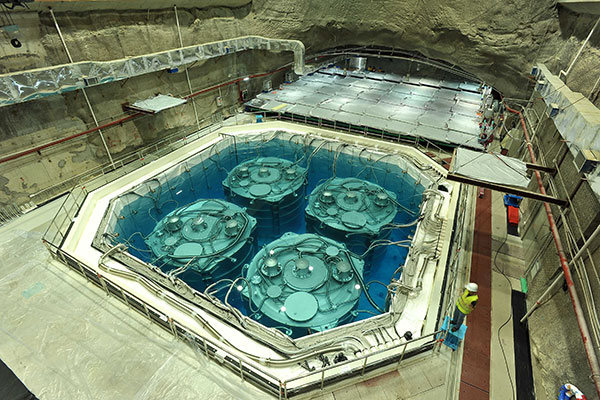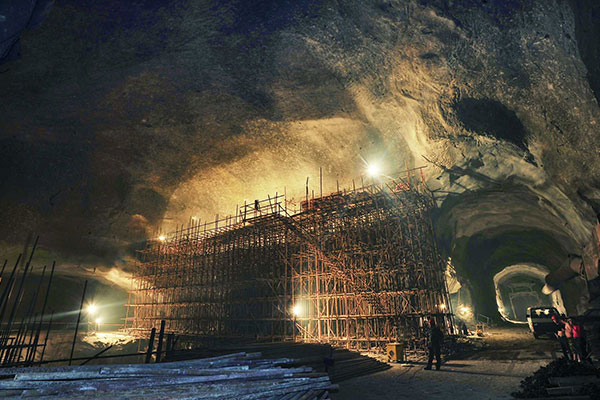
The neutrino experimental facility at Daya Bay will be replaced by a new facility in Jiangmen, Guangdong province, by 2020.[Photo/Xinhua]
For physicists, 2015 has been the year of the neutrino. The minuscule subatomic particle, which is crucial to our understanding of the origins of the universe, is being studied at laboratories across the world, but especially in China.
Earlier this year, the government launched a new neutrino experimental facility project in Jiangmen city, Guangdong province, to replace the existing Daya Bay Reactor Neutrino Experiment by 2020, with the aim of ranking the masses of the three different types of neutrinos. Although the particle itself is neutral, it is part of a “trinity” consisting of three types of neutrino-the electron, muon and tau neutrinos. Under certain circumstances, each type can transform itself into one of the other two.

The Daya Bay Reactor Neutrino Experiment was conducted in this tunnel, shown during construction in 2011.[Photo/Xinhua]
With a budget of 2 billion yuan ($310 million), the Jiangmen Underground Neutrino Observatory, also known as JUNO, will dwarf the Daya Bay project-an international collaboration conducted by several countries and regions-by a factor of about 100.
“We were just lucky in the case of the Daya Bay experiment. We invested less money but made a significant breakthrough in a short time, but this (making a breakthrough so quickly) is unrepeatable,” said Wang Yifang, director of the Institute of High Energy Physics at the Chinese Academy of Sciences, who led the Daya Bay neutrino experiment.
Although the Daya Bay team, based 52 kilometers northeast of Hong Kong and 45 km east of Shenzhen in Guangdong, included physicists from a number of countries and regions, including China, the United States and Russia, more than 60 percent of the funding came from the Chinese mainland.
For the JUNO project, however, the Chinese government will provide 80 percent of the investment, with the rest coming from European countries, including France and Italy, whose scientists did not participate in the Daya Bay experiment. Instead, they were involved with a competing project in France called Double Chooz, construction of which was completed in September last year.
“The reason we chose to build the facility in Jiangmen is that its unique mountain landform is adjacent-approximately 50 km-to a nuclear power plant that can provide us with a free source of neutrinos,” Wang said.
The overall design of the Jiangmen experiment incorporates many features from Daya Bay, but also includes several key technological advancements. “We cannot afford failure if we meet with major setbacks when trying to build such a huge facility from zero. However, we now already have the experience of working at Daya Bay, so we feel confident,” Wang said.
China was a latecomer in the field of neutrino research. The facilities at Daya Bay did not start operating until late 2011. Just four months later, the team announced an astonishing discovery: a new form of neutrino oscillation-the process by which the particle morphs into one of its three forms-a mystery left unsolved by two previous Nobel Prize winners, which were only partially successful in explaining neutrino transformation.
Worldwide attention
The particle has been making headlines across the world recently. In October, the Nobel Prize in Physics was jointly awarded to Takaaki Kajita of the University of Tokyo and Arthur B. McDonald of Queen’s University in Ontario, Canada, for their discovery of neutrino oscillations that confirm neutrinos have mass. It was the fourth time neutrino-related research had won a Nobel Prize.
In November, representatives of five different neutrino experiments accepted the $3 million award for the Fundamental Physics Breakthrough Prize, funded by a number of high-tech entrepreneurs, such as Jack Ma of Alibaba, the Chinese Internet giant, and Facebook’s Mark Zuckerberg.
Scientists hope that neutrino research will capture the public imagination in the same way the discovery of the Higgs boson did three years ago. Also known as the “God particle”, the Higgs boson helps to explain why other elementary particles have mass. Its discovery by the Large Hadron Collider at the European Organization for Nuclear Research, also known as CERN, in July 2012 was regarded as the most significant scientific breakthrough in decades.
A promising field
Now, the neutrino is believed to be the most promising field for discoveries of so-called novel particles, such as the Higgs boson. “After the Higgs boson, exploration of any unknown particles will require new research facilities. As the LHC is hitting the limits of its energy level, we are pinning our hope on neutrino research, and several new facilities are being developed,” Wang said.
At present, there are 18 neutrino facilities in operation worldwide-in the United States, Japan, Europe, Canada, South Korea and China-many of which have ambitious plans for upgrades.
For example, the Kamioka Neutrino Observatory in Japan-which has produced two sets of Nobel-Prize-winning research since it was completed in 1983-had its capacity expanded tenfold in the 1990s, which led to its new designation as the Super-Kamioka. A further expansion is being planned to raise the power level by a factor of 20.
The news that European countries and CERN have decided not to carry out large neutrino oscillation experiments anymore over the next couple of decades so they can focus fully on CERN’s collider program has also provided a boost for China’s research ambitions.
“Since that announcement, the European neutrino community has explored the global opportunities to understand which other ongoing efforts could be joined,” wrote Gioacchino Ranucci of the National Institute of Nuclear Physics in Italy, who is deputy spokesperson for the JUNO experiment, in an e-mail exchange with China Daily.
In the event, the European neutrino community decided overwhelmingly to join and support JUNO. “There has been an evolution and a differentiation of physics priorities in each geographic area of the planet, dictated by the large sizes and budgets of next-generation experiments,” Ranucci said.
Marcos Dracos, a high-energy physicist at the University of Strasbourg in France, who is chair of the JUNO Institutional Board, said the Daya Bay experiments proved China’s research strength, and that has changed the opinions of many European scientists.
“With the Daya Bay discovery, China has proved that it is able to make significant discoveries in fundamental physics on its own soil. In the same way, Chinese particle physicists have also proved that they are able to propose, build and operate large international collaborations. They showed the whole world that they can be trusted, and that they are supported by their country in this field of research,” he said.
In parallel with JUNO, Chinese physicists are also proposing a next-generation collider, and if everything goes as planned, the construction of the Circular Electron Positron Collider will start after 2020, followed by the Super Proton-Proton Collider in 2040-a full upgrade of CERN’s Large Hadron Collider that will require far greater investment than neutrino observatories.
“The construction of JUNO is expected to be completed by 2020. If the CEPC and SPPC projects are approved, I hope they will alternate with each other to help China take a leading role in global high-energy physics research,” said Wang from the physics institute in Beijing.
